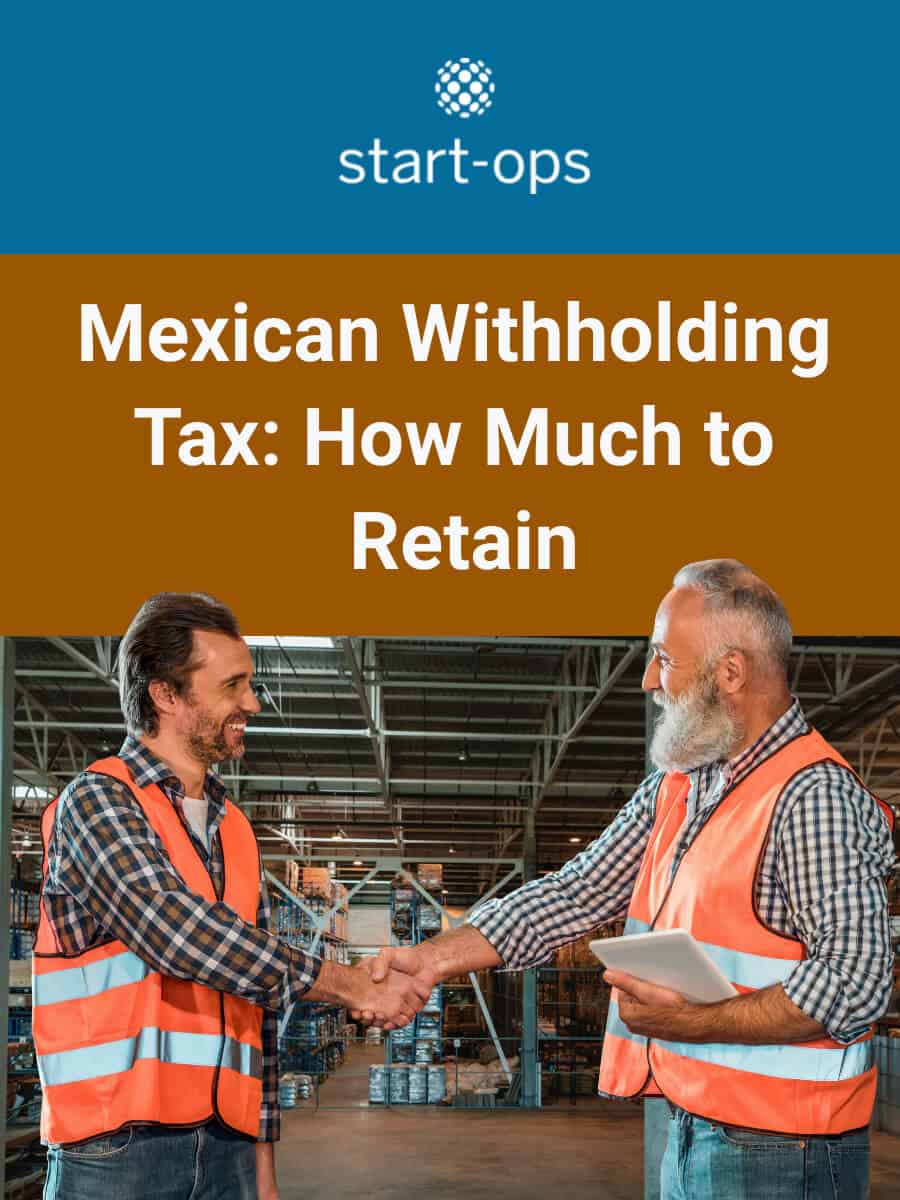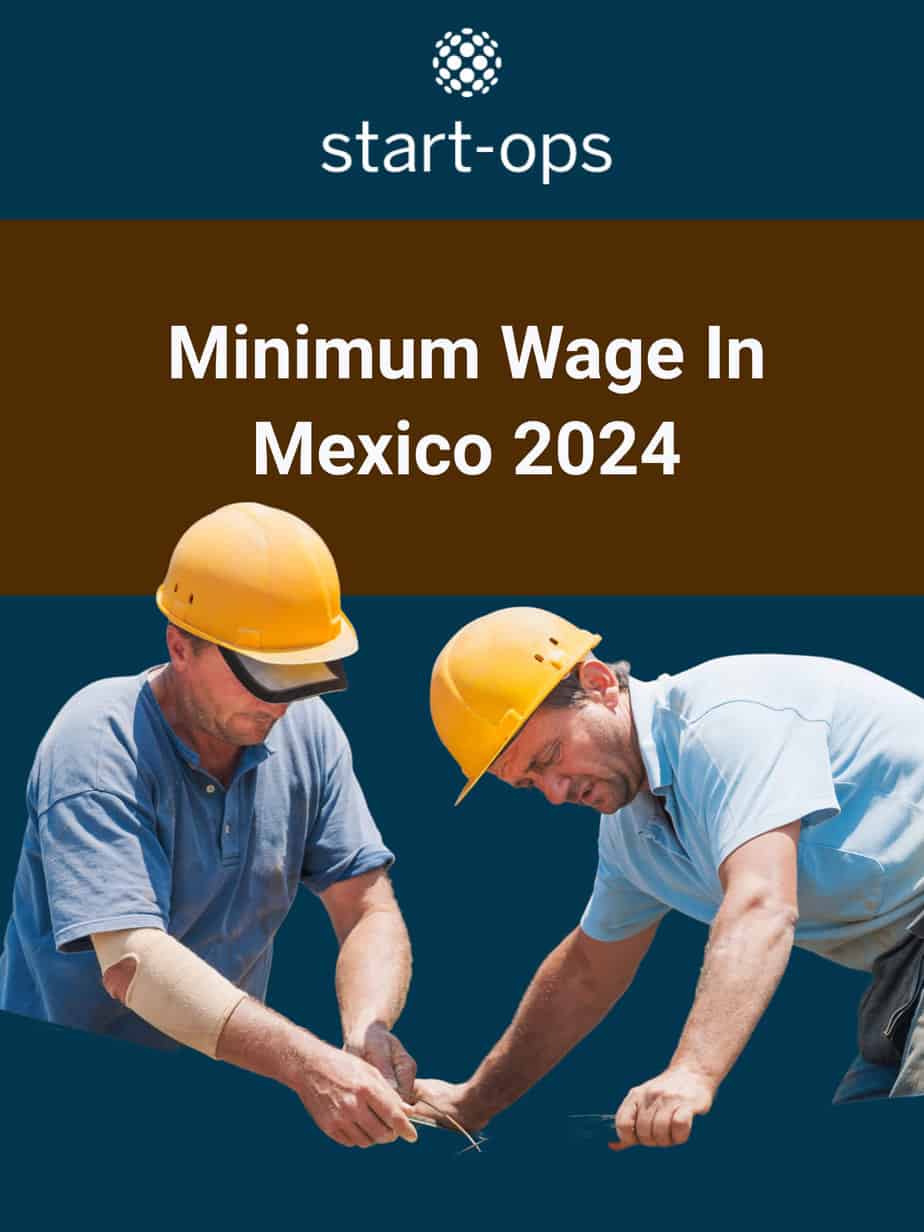Last updated on July 28th, 2023 at 01:48 pm
Mexico VAT tax is a tax that is levied on the consumption of Mexican products and services. The tax is generally levied at 16% on the value of goods (hence Value Added Tax). However, some instances exist where products or services can have a VAT rate of 8%, 0%, or even be exempt. VAT is one of the most important taxes in Mexico.
It’s important to realize that VAT is an indirect tax. Unlike direct taxes, like income tax, indirect taxes are charged directly on wealth or income. In other words, it levies consumption instead of wealth. And regardless of how much the consumer’s income or wealth may be, he has to pay it.
VAT is collected is by being transferred from the final consumer to the tax authority. That is to say, each business assumes a proportional part of the tax in the production stage according to the added value, which we’ll see in more detail in the article.
Understanding VAT is a crucial aspect of starting operations in Mexico. In this article, we will dig into the most critical parts of it.
Article Structure
In short, this article is structured as follows. Firstly, we briefly discuss VAT history and compare Mexico’s VAT tax rate of 16% with other OECD members. Secondly, we talk about how the tax works, how it is transferred from the final consumer to the Mexican tax authority, and how to declare it. Thirdly, we talk about VAT retention, a responsibility delegated by the tax authority to some companies. Fourthly, we talk about Mexican VAT refunds, how it works, and the time it can take for the tax authority to issue a refund. Finally, we discuss the different instances in which a company could end up having a surplus of creditable VAT by performing activities with VAT rates of 8%, 0%, or exempt from VAT.
Mexico VAT Tax History
Mexico’s VAT tax law was published in the Diario Oficial de la Federación DOF (Official Gazette of the Federation) on December 29, 1978, even though it wasn’t enforced until 1980. The government does this with some laws to allow some time for the country to adjust to the new obligations the laws demand. The following is a picture of the recently published law in the official gazette.

Back in the day, before Mexico introduced the Value-Added Tax (VAT) in 1980, we had a Commercial Income Tax (CIT). This tax has existed since 1948 and behaved similarly to VAT, being directly charged on consuming goods and services.
In brief, just like VAT, the CIT was an indirect tax (charged directly on transactions). This means you would be taxed with CIT whenever someone bought something, whether a company or an individual. And, in any case, same as with VAT, it was the seller’s duty to charge it and transfer it to the government.
In effect, the general CIT Tax rate was 4%. However, this tax had a significant downside; it wasn’t credited against the tax your supplier charged. In detail, this means it was added in a cascade style throughout the production process. And, therefore it went against a principle stated in Article 31 of the Mexican Constitution of paying taxes proportionally and equitably.
Mexico’s VAT Compared To The World
We weren’t pioneers in charging VAT tax. When Mexico adopted it, countries like Sweden, Denmark, France, Germany, Italy, and many Latin American countries had already adopted it. At different rates, of course, but the concept is the same.
The advantage of indirect taxes is that they are much easier for governments to collect since they are collected when making purchases. Today, more than 168 countries have adopted some consumption tax.
In the beginning, when VAT was just implemented in Mexico, it started at a 10% rate; this went through many transformations until we arrived at the current 16%.
Is this a lot?
Well, the Organization for Economic Cooperation and Development (OECD) made a study in 2020 finding that standard VAT rates ranged from 27% in Hungary to less than 10% in Switzerland and Canada, averaging its members’ VAT rate at 19.3%.
How Mexican VAT Tax Works
As we already discussed, VAT is a tax transferred from the final consumer to the tax authority, each part of the value chain assuming its proportion according to the value added. Let’s see how this works with a really simple example; a producer of shoes selling to a wholesaler and that shoe wholesaler selling to a retailer.
- Firstly, a shoe manufacturer buys leather and other products in bulk and transforms those materials into shoes. His gross margin is 50%, and he sells every pair of shoes at MXN 100.00 + VAT.
- Secondly, the shoe wholesaler buys many of these shoes and distributes them to retail stores. His gross margin is also 50%, so he sells every pair of shoes at $200.00 + VAT.
- Thirdly, the retailer sells these shoes to the final consumer, making a gross margin of 50%. This means that he sells each pair of shoes for $400.00
Let us see how this looks in practice.

VAT Tax Declaration
Now that we know it works, how and when do we pay the VAT due to the tax authorities?
Firstly, the good news is that Mexico’s VAT tax is based on cash flow, not accrued accounting, which means you only pay VAT on the collected revenue. Otherwise, this could be disastrous for a company. However, companies must present a monthly VAT declaration as corporate and income taxes. This is done through electronic format A-29, an Informative Declaration of Operations with Third Parties or DIOT because of its name in Spanish.
It’s pretty simple. How it works is that using your accounting registries, you input all of the transactions subject to VAT, subtract the creditable VAT from the payable VAT, and pay the government the difference.
Who Pays Mexican VAT Tax?
Let’s get legal. Article 1 of the Mexican Value Added Tax Law states who is subject to the tax, which is pretty much everyone, although there are a few exceptions.
Any company or individual performing the following activities while in Mexican territory shall be subject to VAT tax.
- Sell goods.
- Lease goods
- Provides independent services.
- Imports products or services.
If you think about it, these are almost all commercial activities. Hence, it’s safer to think that you must charge and pay Mexico VAT tax if you start operations in Mexico.
Mexico VAT Tax Retention
As we have discussed, Mexico’s VAT tax comes from the consumer and is transferred to the tax authority by the seller.
However, many sellers weren’t transferring that tax but keeping it. So the government decided to delegate some of its responsibility to companies and have them retain the VAT. This makes sense because they are easier to monitor, and there is a better chance that they will transfer the tax to the government.
Article 1-A of Mexico’s VAT tax law states who is obliged to retain VAT:
- Credit Institutions that acquire goods by seizing
- Legal entities (companies) that:
- Buy professional services from individuals or lease goods from individuals.
- Buy waste
- Buy auto transportation services from natural persons or legal entities.
Some are specific cases, but you can see the government targets here. Most of the retentions are made to individuals that are hard to collect from, e.g., freelancers, people that sell waste, and cab drivers. Therefore, according to this law, if you own a company in Mexico and hire a freelance designer, he doesn’t keep the VAT. At least not all of it.
Let’s see how this example works.
Article 3 of the VAT Law Regulation states that your company needs to retain two-thirds of the tax. Since the tax is 16%, you need to retain 10.6667%. Furthermore, the designer will send you an invoice specifying the retention and VAT charges. You would only pay him a third part of the VAT, and it becomes your company’s responsibility to transfer that third part to the tax authorities.

Mexican VAT Tax Refund
You can request a VAT refund if the difference between payable VAT and creditable VAT is in your favor. But no one likes giving money back, and Mexican tax authorities are not an exemption. So things can get complicated and, what’s worst, lengthy. That said, some foreign trade incentive programs, like the IMMEX program, allow companies to get VAT refunded much faster.
Let’s get legal; Article 6 of Mexico’s VAT Tax Law states that you can request a refund when you have a VAT balance. So to do that, you must fill out a refund form and submit it.
You must show specific documentation that you have a surplus of creditable VAT. This documentation is specified in Annex 1-A of the Miscellaneous Tax Resolution, a group of regulations issued by the Mexican tax authorities annually.
When you apply for a refund, the tax authority must issue the refund in no more than 40 days. Sounds good, but there’s a trick.
During this period, tax authorities may ask for extra information regarding your company’s VAT balance. Furthermore, they can do this up to two different times. The bad news is that the time spent while these requirements are executed doesn’t count towards the 40 days the authority has to refund VAT. Think of it as frozen time.
So how bad can it get? We’ll let’s see how the process works.
VAT Refund Process Example
The authority must issue the first requirement no more than 20 days after applying for a VAT refund. Once the requirement is issued, your company has up to 20 days to submit the documentation. However, some of this documentation can take a long time for companies to gather. So the worst-case scenario is if the authority issues the requirement on day 20 and your company takes 20 days to gather and deliver the documentation. To sum up, this would amount to 40 days of frozen time.
Then again, after this requirement is delivered, tax authorities can require more information from the company if they consider it needed. To this end, they have up to 10 days from when the first requirement was submitted to issue the second requirement. And from the moment the second requirement is issued, your company must submit it in no more than ten days. So the worst-case scenario would be 20 days in this case.
As discussed, those periods in which tax authorities required information and your company gathered it and submitted it doesn’t count toward the initial 40 days, so if you add up all the worst-case scenarios here, a VAT refund can take up to 100 days. For example, this can significantly impact the cash flow of manufacturing companies. It doesn’t mean this happens every time, but it can happen.
VAT Refund Reasons
To clarify, a company in its ordinary course of business would not have a surplus of creditable VAT. Usually, companies buy more than they spend, so payable VAT is more than the creditable VAT.
So what could cause a company to have a surplus of creditable VAT? We are about to see three cases in which the VAT rate is less than 16% and could create this scenario.
VAT Tax On The Mexican Border Region
As discussed, Mexico’s VAT Tax is 16%. However, there are some exemptions to that rule. One of these exemptions is a tax stimulus given to Mexico’s Northern & Southern Border Regions.
Back in 2018, the Northern Border Region Tax Stimulus Decree was issued by our then-president. The idea was to create economic conditions in this region to increase the country’s competitiveness and foster investment. The decree grants the region tax stimulus in income tax and VAT. After a couple of years, since apparently, the stimulus was working, a Southern Border Region Tax Stimulus Decree was issued.
In essence, for the VAT part, the stimulus consists of a credit of 50% of the Mexican VAT tax rate of 16%. In other words, this means you are only obliged to charge and transfer 8%. This decree applies to individuals and companies that sell or lease goods or services as long as they operate in the respective Border Region.
So, what accounts for these border regions?
Mexican Northern Border Region
Article 1 of the Northern Border Region Tax Stimulus Decree states which municipalities conform to the region. You can see them in the following table organized by state.
| State | Municipality |
|---|---|
| Baja California | Ensenada |
| Baja California | Playas de Rosarito |
| Baja California | Tijuana |
| Baja California | Tecate |
| Baja California | Mexicali |
| Sonora | San Luis Río Colorado |
| Sonora | Puerto Peñasco |
| Sonora | General Plutarco Elías Calles |
| Sonora | Caborca |
| Sonora | Altar |
| Sonora | Sáric |
| Sonora | Nogales |
| Sonora | Santa Cruz |
| Sonora | Cananea |
| Sonora | Naco |
| Sonora | Agua Prieta |
| Chihuahua | Janos |
| Chihuahua | Ascensión |
| Chihuahua | Juárez |
| Chihuahua | Práxedis G. Guerrero |
| Chihuahua | Guadalupe |
| Chihuahua | Coyame del Sotol |
| Chihuahua | Ojinaga |
| Chihuahua | Manuel Benavides |
| Coahuila | Ocampo |
| Coahuila | Acuña |
| Coahuila | Zaragoza |
| Coahuila | Jiménez |
| Coahuila | Piedras Negras |
| Coahuila | Nava |
| Coahuila | Guerrero |
| Coahuila | Hidalgo |
| Tamaulipas | Nuevo Laredo |
| Tamaulipas | Guerrero |
| Tamaulipas | Mier |
| Tamaulipas | Miguel Alemán |
| Tamaulipas | Camargo |
| Tamaulipas | Gustavo Díaz Ordaz |
| Tamaulipas | Reynosa |
| Tamaulipas | Río Bravo |
| Tamaulipas | Valle Hermoso |
| Tamaulipas | Matamoros |
Mexican Southern Border Region
According to Article 1 of the Southern Border Region Tax Stimulus Decree the region is comprised of the following municipalities.
| State | Municipality |
|---|---|
| Quintana Roo | Othón P. Blanco |
| Chiapas | Palenque |
| Chiapas | Ocosingo |
| Chiapas | Benemérito de las Américas |
| Chiapas | Marqués de Comillas |
| Chiapas | Maravilla Tenejapa |
| Chiapas | Las Margaritas |
| Chiapas | La Trinitaria |
| Chiapas | Frontera Comalapa |
| Chiapas | Amatenango de la Frontera |
| Chiapas | Mazapa de Madero |
| Chiapas | Motozintla |
| Chiapas | Tapachula |
| Chiapas | Cacahoatán |
| Chiapas | Unión Juárez |
| Chiapas | Tuxtla Chico |
| Chiapas | Metapa |
| Chiapas | Frontera Hidalgo |
| Chiapas | Suchiate |
| Campeche | Calakmul |
| Campeche | Candelaria |
| Tabasco | Balancán |
| Tabasco | Tenosique |
Requirements To Apply To The Border Stimulus
Firstly, like with all things legal in Mexico, it’s not as simple as just charging 8% VAT and being done with it. As a result, for your company to apply for this tax stimulus, a few things need to happen.
First, you have to carry out one of the following activities.
- Selling goods
- Provide services
- Leasing goods
Also, you must deliver your goods or services inside the Northern or Southern Border Region. This means that if your clients are in Mexico City, for example, you wouldn’t be granted the stimulus.
Exemptions to the Stimulus
The following activities cannot apply to the stimulus.
- Importing. If a good or service is being imported, the 16% rate applies.
- Selling of residential property and land.
- Selling & leasing of intangible goods.
- Transportation services that start or finish outside the Northern Border Region.
Mexican VAT 0% Tax Rate
Now that we know there are some instances where an 8% VAT tax can be charged let’s see how the 0% VAT tax rate works.
Specifically, some goods and services have a VAT tax rate of 0%. Given that, there’s no VAT is charged. However, in an invoice, you would see this 0% is charged (as $0).
Why? Well, the cool part is that because of this 0%, you are entitled to ask for a refund. This doesn’t happen with the goods and services exempt from VAT, which we’ll see in the following section.
As of 2022, the selling of the following products has a Mexican VAT rate of 0%; you can find this information in Article 2-A of Mexican VAT tax law.

Exemptions To Mexican VAT
Some activities are exempt from Mexican VAT. In particular, if your revenue comes only from these activities, there is no need to present your VAT declaration. However, the sad news is that you will be charged VAT for all your expenses, and you cannot ask for a refund. Therefore, you will have to account for that VAT as an expense.
The following are activities exempt from VAT in Mexico.

Conclusion
Mexico’s VAT tax rate is 16%. However, there are instances in which this rate can vary depending on the commercial activities performed by a company. Therefore, there are times when a company can end up having a surplus of creditable VAT tax in their favor. For instance, if they charge a VAT tax of 0% because they export goods.
For these cases, the taxpayer can request a VAT refund to the tax authority, provided that they follow the procedure. However, in practice, this can be a lengthy process. To put it in another way, in a worst-case scenario, it can take up to 100 days to get it back.
Moreover, if you liked this article, don’t forget to share it with someone you think may benefit. Also, if you have any questions, leave them in the comments. We would be happy to help you clear your doubts.


